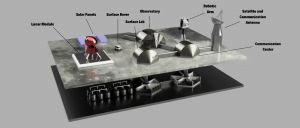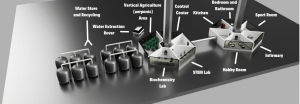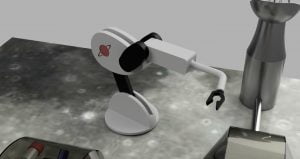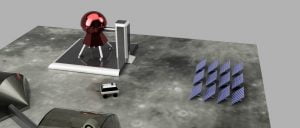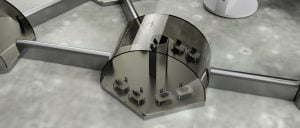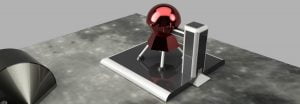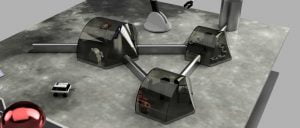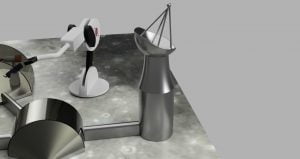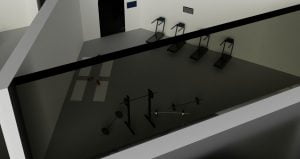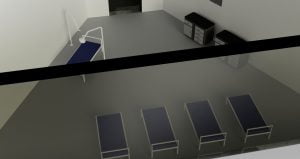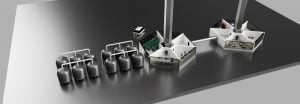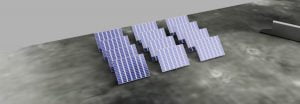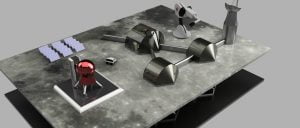Moon Camp Pioneers画廊2020-2021
在Moon Camp Pioneers中,每个团队的任务是使用Fusion 360三维设计一个完整的月球营地。他们还必须解释他们将如何利用当地资源,保护宇航员免受太空的危险,并描述生活和工作设施。
团队。 宇宙月
Özel Bahçeşehir Koleji Fen ve Teknoloji Lisesi 萨姆松 土耳其 14岁或以下,15岁,16岁 第二名--非ESA成员国
3D项目的外部查看器
|
项目描述
我们确保营地易于建造,避免过度使用材料。我们将通过将设计定位在地表下,保护宇航员免受陨石和辐射的影响。 同时,我们通过在地表放置一个火箭平台和电梯,使我们的地下营地更容易降落。有了温室区和水的转换。通过农业气培法,我们还将通过可持续地生产我们自己的食物来满足宇航员的食物需求。通过过滤月球水并使其可以饮用,我们通过使用当地资源来供应生命的一个非常重要的需求。对于太空中的宜居气氛,我们计划首先从地球上获取氮元素,然后通过水电解法生产氧气,并通过营地的通风系统将氧气输送到营地的每个部分。此外,我们还计划用安置在月球表面的太阳能电池板提供营地所需的能源,同时在燃料电池的帮助下,将水解产生的额外氢气转化为能源。我们将把营地安置在沙克尔顿环形山,因为这里的温度值比月球的其他地方更稳定,而且接受更多的阳光照射。在营地的建造阶段,我们计划用3D打印机将月球土壤转化为建筑材料,并通过我们设计的机械臂,实现安全、快速的建造过程。 |
|||
|
你想在哪里建造你的月球营?
We decided to build our camp Shackleton Crater in the South Pole location. First, in this region of the Moon, temperature is more stable. It will be extremely useful to provide an appropriate climate for astronauts. Second reason is that the Shackleton Crater gets sunlight nearly %80-%90 around the year. Therefore we can achieve lots of energy with our solar panels therewithal. Since the Sun’s rays almost always reach this part of the Moon, we won’t need unnecessarily large batteries to power when solar panels can’t provide electricity. As for the third reason, some studies show that there may be water in this part of the month. If it is true, we can access the camp’s needed water more easily. In Our camp design we position the room under the Moon surface to protect astronauts from radiation, possible meteor damage and in this way we can stabilize the inner temperature. 你打算如何建造你的月球营?描述一下你将使用的技术和材料。
我们正计划使用两种不同的方法。其中之一是使用一个巨大的3D打印机来建造我们的营地。我们将用那台巨型3D打印机把月球土壤转化为可打印的材料。通过这种方式,我们将能够使用月球上的当地资源来建造我们的营地。作为另一种可能性,我们认为,建筑材料可以从大麻植物中获得。大麻植物隔热材料是一个很好的选择,因为它很容易生产。由于其密度低,它可以在世界各地以模块化结构生产,并可以很容易地运到月球上。同时,由于它很容易生产,可以用垂直农业生产,可以用于月球站的损坏修复,容易栽培,可以用这个内容为我们提供方便。我们可能只需要从地球上带走一些材料,我们计划用有效载荷火箭把这些少数材料带到月球上。这是一种真正有效的将东西带到月球的方式。机器人手臂旨在有效地在月球表面工作,清洁月球表面并协助建造月球营地。你可以传送各种各样的东西,它是比较安全的。这些机器人将在月球营地建成后继续协助修复结构。所有设备安顿好后,基地将全面投入使用。 月球上的环境对宇航员来说是非常危险的。解释一下你的月球营将如何保护他们。
每年都有数以百计的陨石落在月球表面。而且月球上也有大量的辐射。根据研究,如果要建造的结构用大约50厘米厚的月球土壤覆盖,这就足以保护生物免受辐射。因此,我们将月球营地的主要部分设计为建在月球表面之下。我们需要在许多方面保护宇航员。其中之一是月球表面的温度。在这种温度下,一个人不可能在正常条件下生存。我们正在考虑通过混合大麻植物、水和石灰来应用隔热材料,这是一种具有高隔热性能的轻型材料,不能占用大量空间,以保护营地的内部热量。 解释一下你的月球营将如何为宇航员提供。
|
|||
|
水
|
食品
|
电器
|
空气
|
|
我们的营地用水来自当地的资源。首先,我们用漫游者接收月球水,并将水储存在水箱中,然后用一个特殊的水过滤器过滤水,以便为宇航员的日常使用目的转换水。同时净化废水,如尿液、汗水、洗澡水,并在一个循环中保持新鲜水。因此,我们可以多次使用相同的水,并防止水在我们的月球营地流失。 |
在我们的营地,我们用气培垂直农业种植自己的食物。气培植物不需要任何液体或固体介质来生长。相反,含有营养物质的液体溶液被雾化在悬挂植物的气室中。气耕法是迄今为止最具可持续性的无土栽培技术。此外,我们还计划为我们的宇航员提供以植物为基础的均衡饮食。因为它比传统饮食需要更少的面积和水。 |
在我们的电力系统中,我们希望通过我们安置在月球表面的太阳能电池板来使用可再生能源。当我们选择营地位置时,我们考虑将太阳能农场放置在一个可以获得效率的地方。为此,我们决定将营地建在南安普顿极地的沙克尔顿标准上。同时,我们使用来自水电解的额外氢气(H),并通过使用燃料电池从中获取能量。收集的能量储存在电池中,用于照明系统、通风系统、水循环系统等。 |
We need about %78 nitrogen, %21 oxygen and %1 other element for livable atmosphere . We will have a computer that will monitor pressure, O2, humidity and CO2 levels. We will use the water from the Moon ice to supply the required oxygen by water electrolysis . With this process, we will also obtain hydrogen gas that can be reused later in the getting energy purpose. We aim to supply the rest of the components except hydrogen from the world and then protect the cycle. Oxygen is delivered to every part of the camp through the ventilation system. |
|
解释一下你的月球营的主要目的是什么(例如:商业、科学和/或旅游目的)。
作为一个团队,我们真正意识到,月球是一个进行科学研究的好地方。因此,我们月球营的主要目的是在月球上进行科学研究。在我们的营地,我们有四个科学实验室。其中一个是月球实验室。在我们的月球实验室,我们做关于月球土壤、月球水等的研究。我们还有一个用于生物和化学资源的生物化学实验室和一个用于科学、技术、工程和数学学科的STEM实验室。我们在地面上有一个实验室用于天文观测。尽管我们的主要目的是在月球上进行科学研究,但我们也将为我们的营地提供社会领域的支持,如兴趣室、健身室、公共区域等,为宇航员提供心理健康。 |
|||
|
描述一下你们月球营宇航员团队在月球上的一天。
Humans have been settled to a 24-hour daily cycle through millions of years of human evolution. On the Moon, the situation is somewhat different. The sun is always up, so camp residents need to adapt to these conditions and make a well adjusted plan for daily activity for exemple sleep, research, education, and eating well balanced meal astronauts will work in shifts because in this way they can maintain camp daily order and if they get face to face some problems they can fix the problem more easily and on time. So not all their sleeping schedules will be the same. Sleep plays a big role in human mental health and productivity throughout the day so astronauts should get their sleep at less than eight hour. When they get up and feel ready to start the day first they will do personal hygiene work for example brushing their teeth, taking shower etc. Then they will do some stretching exercises to stretch out the muscle and have a good start the day. Next they do two hours of exercise in a centripetal artificial gravity space station. This step is really important because the Moon’s environment damages astronauts’ bone and muscle health . %1-2 of bone mass can be deteriorated in just one month. We plan to feed the astronaut with %100 plant based balanced and regular diet three times a day produced by our vertical agriculture system. In this way astronauts can access local, environmentally friendly, nutritious food. Astronauts will work around 8-9 hour a day. Throughout the day, crew members carry out their work in line with their areas of expertise. In the Moon camp at least one medical specialist and mechanical engineer must be a crew member. Because one astronaut, an infrared medical specialist intervenes as soon as possible and a mechanical engineer is responsible for training of the operation and regular maintenance of mechanical vehicles (water pump system etc.) . At the end of a working day astronauts have free time. They can read a (e)book, play some games, watch a movie, play instruments and talk to their family and friends. End of the day they will change shifts with their teammate and at night, they will have between 8-10 hours to rest. |
|||


